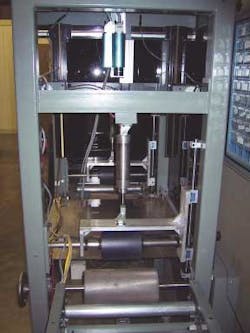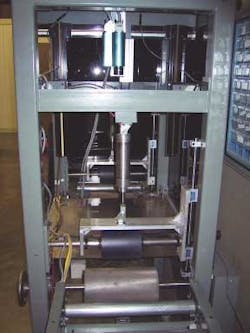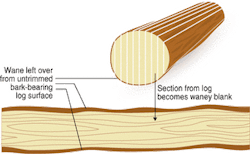Vision inspection grades rough wooden boards
Laser-scanner and smart-camera system automatically determines a rough wooden plank's dimensions, grains, and defects for cost-efficient cutting.
By C. G. Masi, Contributing Editor
Says Philip A. Araman, research project leader at the USDA Forest Service Southern Research Station, affiliated with Virginia Polytechnic Institute and State University (Virginia Tech; Blacksburg, VA, USA), "The problem we're trying to solve, is to develop an advanced scanning and analysis system for converting what we call waney-edged boards into lumber. We're also trying to pick up any holes, knots, decays, splits, and fiber separations," Araman adds.
For rough-cut boards, each cut goes all the way across a chord of the log's cross section (see Fig. 1). The rough, unprocessed edges—defined by the log's outside bark-bearing surface—are called "wane." Sections of the wane have to be removed to produce high-quality hardwood lumber.
Araman's engineering team, including Lynn Abbott, associate professor in the Bradley department of electrical and computer engineering at Virginia Tech, has worked for several years to develop a machine-vision system that can identify wane and surface defects on rough boards (see photo on p. 34).
"The problem is tougher than it appears at first glance," says Abbott. "Wood grain is highly variable in appearance, and that makes it difficult to develop image-analysis algorithms and software."
Araman and Abbott have led the development of a prototype scanning system that can reconstruct a board in the computer. Their system examines the board to figure out the most advantageous way to cut it into the highest-value lumber possible. After locating wane and defects, the computer considers many potential saw positions and selects the cuts that will result in the greatest monetary value, before an edger or trimsaw ever touches wood.
Small- and medium-sized mills have used a manual inspection system that has laser light sources to help human operators visualize the cuts the saw will make. Waney-edged boards come across a conveyor to an operator who runs an edger machine. This machine contains a saw on its two sides, and the operator adjusts the saw blades to cut each board.
Large-sized sawmills have installed automated inspection systems that implement scanning and automated processing capabilities. These systems use laser profilometry to analyze the boards prior to cutting. Generally, the mill superintendent establishes board standards, such as allowing no more than 5% wane on both edges of the board. The host computer then automatically sets the edger saws to produce a board that meets that specification.
"We did tests in three different sawmills," Araman reports. "The worst sawmill got 60% of the value that it should have gotten from the processed boards. The best sawmill got close to 80%."
Multimode scanner
"We're trying to add more information to the decision-making process," says Araman. "We want to pick up the shape of the board, the wane, and the major defects that all help determine the board's grade, and therefore, its sale value."
The engineering team selected a multimodal scanner that uses multiple sensing technologies to analyze the board, map the wane, and locate the defects. Then, the team reconstructs the board's profile in the computer. Last, the computer model of the board is processed by a custom program that determines where to edge-trim the board for maximum sales value.
"This system," Araman says, "mainly uses off-the-shelf solid-state lasers and a black-and-white smart camera." The camera, a MAPP 2200, is manufactured by Integrated Vision Products (Woodinville, WA, USA). Key camera features include 256 × 256-pixel resolution, a 400- to 1050-nm spectral range, a 4-MHz instruction rate for 62 instructions, and a 1.5-µs to 100-ms integration time.
The camera's smart vision sensor combines an image sensor, analog-to-digital converters, and general-purpose image processors on one semiconductor chip. It comes with optimized code sequences, including a number of low-level routines for image arithmetic, pattern recognition, edge detection, convolution, median filters, and high-speed 3-D profiling routines.
Araman says, "On some of our initial work we tried to used a color linescan camera to separate the wood by color, but we got too many color variations on the same piece of wood." Unfortunately, the color camera responded to cosmetic variations that were not real defects. A software program had to filter out these variations. Upon investigation, the engineering team found it could obtain all the necessary imaging information with a black-and-white-camera-based system that avoided the variation problems.
The multimode scanner system uses three lasers, one top view and two side views, to form a structured-light pattern (see Fig. 2). The top-view laser is oriented at an angle to obtain profiling. Software performs triangulation to map the wane and pick up defects that affect the board's surface, such as holes or splits. The other two lasers are pointed at the sides of the board and are used to derive a gray-scale image and an image of the tracheid effect (pores formed by the wood fibers).
The gray-scale information, which comes from reflections from the plank's top surface, originates in the laser beams' footprint—the region where the incident beam touches the wood surface. The tracheid information, however, comes from light scattering within the wood and emerges outside of the beams' footprint. The gray-scale image is used to determine blemishes in decaying wood. This defect affects wood reflectance at the laser wavelength, but does not affect the grain structure or surface morphology.
The tracheid image picks up minute grain patterns on the board (see Fig. 3). In a piece of wood that has a straight grain and does not have any defects, the tracheids generally line up in one direction down along the board. When the fibers meet a natural defect, such as a knot, they go around the defect, bending their orientation to parallel the defect's surface.
The tracheid effect picks up defects that primarily affect the grain structure. In a knot, for example, the tracheids line up perpendicular to the surface and squelch the tracheid effect.Among the three modalities, Araman and Abbott's team found that they could identify a large percentage of the defects that hardwood planks are likely to exhibit at this stage of the lumber-conversion process.
The system software analyzes the collected data for each plank (see Fig. 4). This analysis starts with the profile image. The software removes the background and highlights features of interest, which (at this stage) include the wane position and any voids. Further analysis combines this information with the tracheid and gray-scale-derived information to identify suspicious regions for more thorough analysis by the modular artificial neural network (MANN). Within the MANN, a multilayer perceptron network identifies clear wood, and a statistically trained radial-basis function network labels the knots and decay. A competitive-decision scheme resolves the output from these two networks. Its conclusions, along with the profilometry results, go to the nex step for postprocessing.
The postprocessing analysis produces a six-way decision for every 1.6-mm (1/16-in.) section of the plank. For each spot, it identifies the material within a split, decayed area, knot, hole, wane, or clear wood.
The team tested the system in their laboratory using dozens of rough boards from area sawmills. Then the team compared the scanner results with "ground truths," which are obtained by carefully inspecting each spot on each log. The scanning system identified wane boundaries with a measurement uncertainty of 3/16 in. (5 mm). It detected defective areas and identified the type of defect with a pixel noise classification accuracy of 96.7% "The prototype scanning system has demonstrated the feasibility of using machine-vision technology to improve sawmill operations," concludes Araman.
features, advantanges, benefits
Lynn Abbott, associate professor in the Virginia Tech Bradley Department of Electrical and Computer Engineering, worked with Philip Araman's team to develop a machine-vision system to identify wane and surface defects on rough boards and figure out the most advantageous way to cut board into the highest-value lumber possible. "Wood grain is variable in appearance, and that makes it difficult to develop image-analysis algorithms and software," Abbott says. "The MAPP 2200 'smart camera' contains an internal processor that can be programmed to process images as they are captured and before information is transferred to a host PC. The architecture supports the manipulation of complete image rows simultaneously. This facilitates the averaging of several image rows rapidly, as well as a thresholding operation that can be used for high-speed profiling applications." Abbott used these capabilities to combine information from the various imaging modalities to detect wane and voids and to identify suspicious regions before sending information along for additional processing.
Info
Integrated Vision Products www.ivpvision.com
Virginia Tech/USDA Forest Service Southern Research Station www.srs4702.forprod.vt.edu





